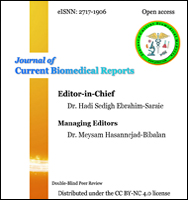Investigating the frequency of skin manifestation in newborns admitted to a Children's Hospital in the North of Iran
Abstract
Skin manifestations, a common problem in infants, can be a serious concern for parents. Most manifestations are benign and transient, but some of them need more evaluation regarding whether they can negatively affect infant health. In this study, it is aimed to evaluate the frequency of skin manifestation in newborns admitted to the department of newborns and NICU from 2019 to 2020. This cross-sectional was performed on infants hospitalized in the department of pediatrics and NICU of a pediatric hospital in Guilan, Iran, from 2019 to 2020. The sampling was performed using the census method. The information was gathered using a checklist of infant and mother characteristics. Out of 323 newborns, 164 cases had skin lesions (50.8%). The lesions of Erythema toxicum, Cutis marmorata, Diaper dermatitis, Milia, salmon patch, and Mongolian spots were presented at 14.9%, 9.9%, 8.1%, 5.6%, 4.3%, and 2.8%, respectively. Only 5.38% of infants required treatment. There was no significant relationship between skin lesions and demographic factors of gestational age, type of delivery, or the family history of dermatological diseases. The rate of skin lesions was moderate to high in hospitalized newborns. In addition, Erythema toxicum, Cutis marmorata, Diaper dermatitis, Salmon patch, and Mongolian spots were more prevalent in infants. These findings can help pediatric physicians effectively in their early diagnosis and therapeutic procedures.
Keywords
Full Text:
Full-text PDFReferences
Haveri FT, Inamadar AC. A cross-sectional prospective study of cutaneous lesions in newborn. ISRN Dermatol. 2014;2014:360590. http://dx.doi.org/10.1155/2014/360590 http://www.ncbi.nlm.nih.gov/pubmed/24575304
Techasatian L, Sanaphay V, Paopongsawan P, Schachner LA. Neonatal Birthmarks: A Prospective Survey in 1000 Neonates. Glob Pediatr Health. 2019;6:2333794X19835668. http://dx.doi.org/10.1177/2333794X19835668 http://www.ncbi.nlm.nih.gov/pubmed/30956996
Jain N, Rathore B, Agarwal A, Bhardwaj A. Cutaneous lesions in neonates admitted in a tertiary setup neonatal intensive care unit. Indian J Paediatr Dermatol. 2013;14(3):62-6. http://dx.doi.org/10.4103/2319-7250.122164
O'Connor NR, McLaughlin MR, Ham P. Newborn skin: part I. Common rashes. American family physician. 2008;77(1):47-52.
Magin PJ, Adams J, Pond CD, Smith W. Topical and oral CAM in acne: a review of the empirical evidence and a consideration of its context. Complement Ther Med. 2006;14(1):62-76. http://dx.doi.org/10.1016/j.ctim.2005.10.007 http://www.ncbi.nlm.nih.gov/pubmed/16473756
Ben-Gashir MA, Seed PT, Hay RJ. Are quality of family life and disease severity related in childhood atopic dermatitis? J Eur Acad Dermatol Venereol. 2002;16(5):455-62. http://dx.doi.org/10.1046/j.1468-3083.2002.00495.x http://www.ncbi.nlm.nih.gov/pubmed/12428837
Golchie J, Ramezanpoor A. Prevalence of contagious skin diseases in Rasht Lakan Prison. J Guilan Univ Med Sci. 2003;11(44):9-13.
Malekzad F, Rahmati M, Taheri A. Prevalence of skin diseases among nursing home patients in elderly home nursings in North of Tehran. Pajoohandeh J. 2007;12(3):253-8.
Soleymani-Ahmadi M, Safa O, Zare S. Prevalence of scabies in soldiers of Bandar Abbas air force base, 2001. Hormozgan Med J. 2002;6(1):15-9.
Ansarin H, Abbasi Moin S. Prevalence of pruritic skin diseases in elderly persons living in Kahrizak Institute in Tehran in first half of 1379. Iranian J Dermatol. 2001;5(1):34-8.
Abbott MB, Vlasses CH. Nelson Textbook of Pediatrics. Jama. 2011;306(21):2387-8. http://dx.doi.org/10.1001/jama.2011.1775
Weiner GM, Zaichkin J. American Academy of Pediatrics; American Heart Association. 7th ed ed. Elk Grove Village: IL: American Academy of Pediatrics; 2016.
Abkenar MJ, Mojen LK, Shakeri F, Varzeshnejad M. Skin injuries and its related factors in the neonatal intensive care unit. Iran J Neonatol. 2020;11(4):93-8.
Firouzi H, Jalalimehr I, Ostadi Z, Rahimi S. Cutaneous Lesions in Iranian Neonates and Their Relationships with Maternal-Neonatal Factors: A Prospective Cross-Sectional Study. Dermatol Res Pract. 2020;2020:8410165. http://dx.doi.org/10.1155/2020/8410165 http://www.ncbi.nlm.nih.gov/pubmed/32425998
Reginatto FP, DeVilla D, Muller FM, Peruzzo J, Peres LP, Steglich RB, et al. Prevalence and characterization of neonatal skin disorders in the first 72h of life. J Pediatr (Rio J). 2017;93(3):238-45. http://dx.doi.org/10.1016/j.jped.2016.06.010 http://www.ncbi.nlm.nih.gov/pubmed/27875703
Gupta D, Thappa DM. Mongolian spots--a prospective study. Pediatr Dermatol. 2013;30(6):683-8. http://dx.doi.org/10.1111/pde.12191 http://www.ncbi.nlm.nih.gov/pubmed/23834326
Gupta D, Thappa DM. Mongolian spots. Indian J Dermatol Venereol Leprol. 2013;79(4):469-78. http://dx.doi.org/10.4103/0378-6323.113074 http://www.ncbi.nlm.nih.gov/pubmed/23760316
Hosseinabad M. A review of cutaneous manifestations in newborn infants. Der Pharm Lett. 2017;9:1-8.
Reza AM, Farahnaz GZ, Hamideh S, Alinaghi SA, Saeed Z, Mostafa H. Incidence of Mongolian spots and its common sites at two university hospitals in Tehran, Iran. Pediatr Dermatol. 2010;27(4):397-8. http://dx.doi.org/10.1111/j.1525-1470.2010.01168.x http://www.ncbi.nlm.nih.gov/pubmed/20653863
Maher MHK, Abady SH, Tabrizi A. Salmon patch and Mongolian spot frequency in the northwest of Iran: a descriptive study. Iranian J Neonatol. 2016;7(3):24-8.
Sadeghzadeh M, Khoshnevisasl P, Mazloomzadeh S, Zanjani A. The incidence of birthmarks in neonates born in Zanjan, Iran. J Clin Neonatol. 2015;4(1):8. http://dx.doi.org/10.4103/2249-4847.151158
Abraham R, Meszes A, Gyurkovits Z, Bakki J, Orvos H, Csoma ZR. Cutaneous lesions and disorders in healthy neonates and their relationships with maternal-neonatal factors: a cross-sectional study. World J Pediatr. 2017;13(6):571-6. http://dx.doi.org/10.1007/s12519-017-0063-0 http://www.ncbi.nlm.nih.gov/pubmed/29058251
Giuffrida R, Borgia F, De Pasquale L, Guarneri F, Cacace C, Cannavo SP. Skin lesions in preterm and term newborns from Southern Italy and their relationship to neonatal, parental and pregnancy-related variables. G Ital Dermatol Venereol. 2019;154(4):400-4. http://dx.doi.org/10.23736/S0392-0488.18.06068-6 http://www.ncbi.nlm.nih.gov/pubmed/29963807
Shajari H, Shajari A, Habiby NSM. The incidence of birthmarks in Iranian neonates. Acta Medica Iranica. 2007;45(5):424-6
DOI: https://doi.org/10.52547/JCBioR.4.2.168
Refbacks
- There are currently no refbacks.
Copyright (c) 2023 © The Author(s)

This work is licensed under a Creative Commons Attribution-NonCommercial 4.0 International License.













